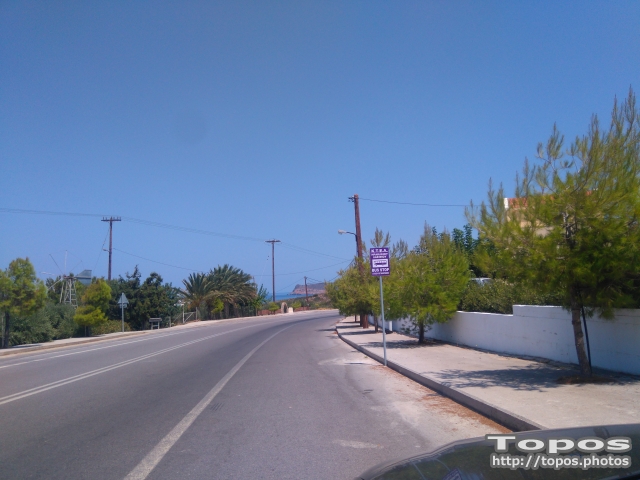Your Position:
Unknown
Στάση Λεωφορείου
Νομός: Λασιθίου
Προτείνετε
Προτείνετε
Η γνώμη σας

Αν θέλετε να μας πείτε την άποψη σας γι αυτήν την τοποθεσία, θα σας παρακαλούσαμε να γράψετε ένα σχόλιο.
Σχολιάστε:
Μέρη κοντινά με Στάση Λεωφορείου
Archaeological Site in Agia Fotia Sitia, East Crete: This is an area of great archaeological interest because, in addition to various chance finds and signs of habitation in the cave of Koufoto on the shore, a large necropolis came to light near the cave (at a place now known as Patima).
252 graves of the early minoan period were discovered and it is estimated that another 50 must have been destroyed by cultivation of the surrounding land. It is the largest Minoan cemetery so far found in Crete. The graves are of an early chamber tomb type with an antechamber and a main chamber, though there are also simple pit tombs which probably contained child burials. Almost all the tombs contained more than one burial.
Archaeological Site in Agia Fotia Sitia, East Crete Archaeological Site in Agia Fotia Sitia, East Crete
The finds were very rich, including about 1800 vessels of various types and in excellent conditfon, an extremely interesting collection of bronze objects among which were fish hooks, daggers, spearheads etc, and also a number of noteworthy stone artefacts such as axes and querns. The finding of two lead zoomorphic amulets is considered important. The excavator, Ephor of Antiquities Kostis Davaras, believes that they lend substance to the view that lead, like silver, was regarded as a precious metal in the early Minoan period.
Some scholars believe that the cemetery belonged to the prehistoric Cycladic settlers in Crete.
From the book "Sitia", N.Papadakis, Archaeologist,1983
252 graves of the early minoan period were discovered and it is estimated that another 50 must have been destroyed by cultivation of the surrounding land. It is the largest Minoan cemetery so far found in Crete. The graves are of an early chamber tomb type with an antechamber and a main chamber, though there are also simple pit tombs which probably contained child burials. Almost all the tombs contained more than one burial.
Archaeological Site in Agia Fotia Sitia, East Crete Archaeological Site in Agia Fotia Sitia, East Crete
The finds were very rich, including about 1800 vessels of various types and in excellent conditfon, an extremely interesting collection of bronze objects among which were fish hooks, daggers, spearheads etc, and also a number of noteworthy stone artefacts such as axes and querns. The finding of two lead zoomorphic amulets is considered important. The excavator, Ephor of Antiquities Kostis Davaras, believes that they lend substance to the view that lead, like silver, was regarded as a precious metal in the early Minoan period.
Some scholars believe that the cemetery belonged to the prehistoric Cycladic settlers in Crete.
From the book "Sitia", N.Papadakis, Archaeologist,1983
Archaeological Site in Agia Fotia Sitia, East Crete: This is an area of great archaeological interest because, in addition to various chance finds and signs of habitation in the cave of Koufoto on the shore, a large necropolis came to light near the cave (at a place now known as Patima).
252 graves of the early minoan period were discovered and it is estimated that another 50 must have been destroyed by cultivation of the surrounding land. It is the largest Minoan cemetery so far found in Crete. The graves are of an early chamber tomb type with an antechamber and a main chamber, though there are also simple pit tombs which probably contained child burials. Almost all the tombs contained more than one burial.
Archaeological Site in Agia Fotia Sitia, East Crete Archaeological Site in Agia Fotia Sitia, East Crete
The finds were very rich, including about 1800 vessels of various types and in excellent conditfon, an extremely interesting collection of bronze objects among which were fish hooks, daggers, spearheads etc, and also a number of noteworthy stone artefacts such as axes and querns. The finding of two lead zoomorphic amulets is considered important. The excavator, Ephor of Antiquities Kostis Davaras, believes that they lend substance to the view that lead, like silver, was regarded as a precious metal in the early Minoan period.
Some scholars believe that the cemetery belonged to the prehistoric Cycladic settlers in Crete.
From the book "Sitia", N.Papadakis, Archaeologist,1983
252 graves of the early minoan period were discovered and it is estimated that another 50 must have been destroyed by cultivation of the surrounding land. It is the largest Minoan cemetery so far found in Crete. The graves are of an early chamber tomb type with an antechamber and a main chamber, though there are also simple pit tombs which probably contained child burials. Almost all the tombs contained more than one burial.
Archaeological Site in Agia Fotia Sitia, East Crete Archaeological Site in Agia Fotia Sitia, East Crete
The finds were very rich, including about 1800 vessels of various types and in excellent conditfon, an extremely interesting collection of bronze objects among which were fish hooks, daggers, spearheads etc, and also a number of noteworthy stone artefacts such as axes and querns. The finding of two lead zoomorphic amulets is considered important. The excavator, Ephor of Antiquities Kostis Davaras, believes that they lend substance to the view that lead, like silver, was regarded as a precious metal in the early Minoan period.
Some scholars believe that the cemetery belonged to the prehistoric Cycladic settlers in Crete.
From the book "Sitia", N.Papadakis, Archaeologist,1983




